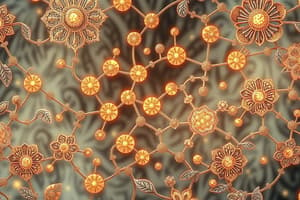Podcast
Questions and Answers
What is the primary function of Glutathione?
What is the primary function of Glutathione?
- Source of amino acids
- Antioxidant (correct)
- Hormone
- Energy storage
What is the Isoelectric Point (pI)?
What is the Isoelectric Point (pI)?
The pH at which the net charge of an amino acid is zero.
Serotonin is a type of neurotransmitter.
Serotonin is a type of neurotransmitter.
True (A)
The transport form of ammonia is known as __________.
The transport form of ammonia is known as __________.
Which of the following amino acids is considered nonpolar?
Which of the following amino acids is considered nonpolar?
What is the role of chaperones in protein folding?
What is the role of chaperones in protein folding?
Which amino acid is a precursor for the neurotransmitter serotonin?
Which amino acid is a precursor for the neurotransmitter serotonin?
The chemical group of amino acids that determines their polarity is called the __________.
The chemical group of amino acids that determines their polarity is called the __________.
Match the following amino acids with their properties:
Match the following amino acids with their properties:
Flashcards are hidden until you start studying
Study Notes
Amino Acids and Their Functions
- Tyrosine and Cysteine are significant amino acids involved in various metabolic processes.
- Phenylketonuria is a genetic disorder affecting phenylalanine metabolism, leading to its elevation in the body.
- Histamine is synthesized from amino acids and plays a role in immune responses and neurotransmission.
- Nitric oxide acts as a signaling molecule and is related to cardiovascular health.
Biochemical Pathways
- Ammonia functions as a transport form of nitrogen in the body, significant in urea cycle metabolism.
- Coenzyme A is vital for the synthesis of fatty acids and energy metabolism.
- Glutathione is an important antioxidant that protects cells from oxidative stress.
Protein Structure
- Amino acids have weakly acidic carboxyl groups and basic amino groups, influencing their behavior in varying pH environments.
- The isoelectric point (pI) is where a protein has no net charge, affecting its solubility and structure.
- Protein folding involves interactions such as hydrogen bonds and hydrophobic interactions, forming structures like α-helices and β-sheets.
Peptide Bonds
- Peptide bonds link amino acids, creating polypeptides, with specific configurations influencing protein function.
- The backbone of polypeptides includes amide and carbonyl groups, crucial for structural integrity.
Protein Folding and Chaperones
- Protein folding is a complex process often assisted by chaperone proteins, ensuring accurate three-dimensional structures.
- Various folding patterns include β-sheets, α-helices, and motifs like Greek keys and hairpins, which are integral to protein functionality.
Acid-Base Properties of Amino Acids
- Amino acids exhibit different properties based on their side chains, categorized as acidic, basic, polar, or nonpolar.
- The net charge of an amino acid is dependent on the pH of the environment, affecting its interactions and solubility.
Key Points on Antioxidants
- Glutathione (composed of Glu-Cys-Gly) serves as a major antioxidant, defending the body from reactive oxygen species.
Summary of Amino Acid Characteristics
- The behavior of amino acids and their net charge is determined by the pH, with a neutral pH yielding a overall charge of zero in proteins.
- The composition and sequence of amino acids define the primary structure of proteins, influencing their higher-order structures and functions.
Studying That Suits You
Use AI to generate personalized quizzes and flashcards to suit your learning preferences.




